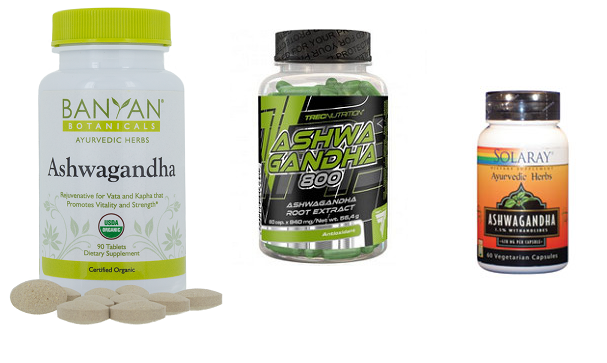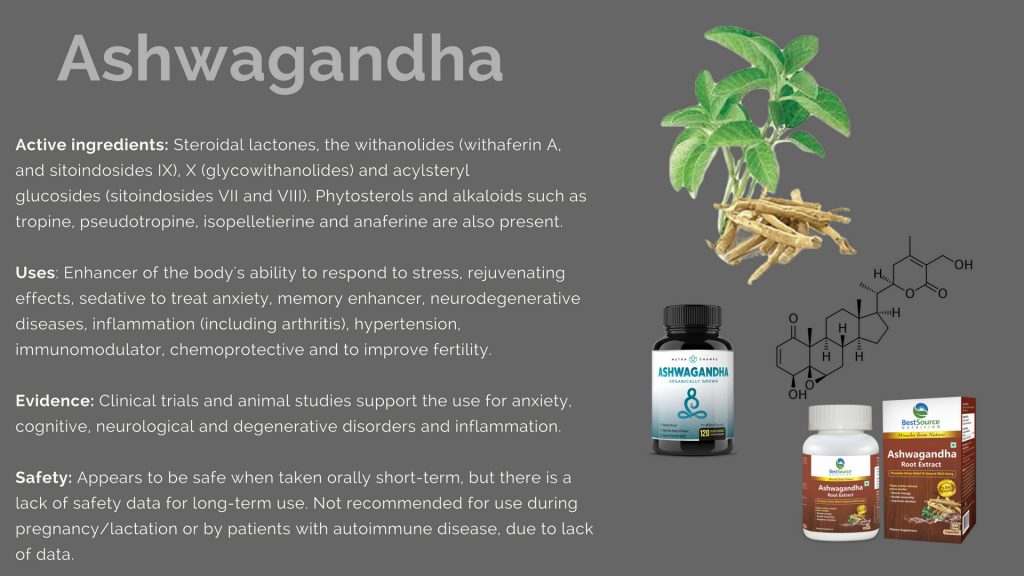Contents
- What is Ashwagandha?
- Ashwagandha family, other names, origin, and botanical drug used
- Ashwagandha’s chemical composition and main compounds
- Ashwagandha indications and uses
- Ashwagandha evidence of efficacy
- Ashwagandha mechanism of action
- Ashwagandha side effects
- Ashwagandha interactions
- Ashwagandha contraindications
- Ashwagandha dosage
- Ashwagandha sedative, anti-aging and anti-stress effects
- Ashwagandha effects on the immune system
- Ashwagandha adjunctive use with cancer chemotherapy
- Ashwagandha anti-inflammatory effects
- Ashwagandha use for memory improvement in Alzheimer disease
- Ashwagandha use for drug addiction
- Ashwagandha use for epilepsy
- Ashwagandha products
What is Ashwagandha?
Ashwagandha or Withania somnifera L., is a green shrub of the family Solanaceae. It is widely considered as the Indian ginseng. In Ayurveda medicine, ashwagandha is known as a rasayana (eng. rejuvenation) and is used to promote physical and mental health, rejuvenate the body in debilitated health states and increase longevity.
Having wide range of activity, it is used to treat almost all disorders that affect the human health. There are various considerations that Ashwagandha may habe various effects on central nervous system (CNS) disorders, particularly in epilepsy, stress and neurodegenerative diseases such as Parkinson’s and Alzheimer’s disorders, cerebral ischemia, tardive dyskinesia and even in the management of drug addiction.

Ashwagandha family, other names, origin, and botanical drug used
Family: Solanaceae
Other names: Physalis somnifera L.; W. kansuensis K.Z.Kuang & A.M.Lu; W. microphysalis Suess.
Origin: Ashwagandha is one of the most important medicinal plants used in Asian medicine, it is found in over 200 formulations employed in Ayurvedic, Unani and Siddha medicine. It is also of economic importance and is cultivated in several regions of India. It is also used in Ayurveda medicine.
Botanical drug used: Roots; more rarely leaf and berries
Ashwagandha’s chemical composition and main compounds
The major active ingredients of Ashwagandha are steroidal alkaloids and lactones, a class of constituents which are known as withanolides (steroidal lactones with ergostane skeleton). The withanolides have the structural resemblance with the active constituents present in the plant Panax ginseng known as ginsenosides. Therefore, because of this Ashwagandha is named as an “Indian Ginseng”.
So far 12 alkaloids, 35 withanoloids and several sitoindosides have been isolated and their structures have been elucidated. Various alkaloids include molecules such as withanine, withananine, psuedo-withanine, somnine, somniferine, somniferinine, tropine, 3-α-gloyloxytropane, psuedotropine, choline, isopelletierine, cuscohygrine, anaferine and anahydrine. Two acyl-steryl glucoside are sitoindoside VII and sitoindoside VIII, and two glycowithanoloids sitoindoside IX and sitoindoside X. They have been isolated from the root.

Withaferin A has been showed to be an inhibitor of angiogenesis and therefore protective in certain types of cancers. Two glycowithanoloids named sitoindoside IX or sitoindoside X have antistress activity and may augment learning acquisition and memory retention according to the studies on rats. Recently, two new steroidal lactones of the withanolide-type have been isolated from the fruits of W. somnifera. The diverse active constituents present in different parts of the plant are believed to be responsible for the multiple medicinal properties of W. somnifera.
Ashwagandha indications and uses
- Ashwagandha is considered to be an adaptogen in herbal medicine and a Rasayana in Ayurveda, that is to enhance the body’s ability to respond to stress and have rejuvenating effects.
- It is used as a sedative to treat anxiety, enhance memory, treat neurodegenerative diseases, reduce inflammation (including arthritis), lower blood pressure, modulate the immune system and improve fertility.
- More recently, it has been used as an adjunctive therapy for serious disorders including cancer and infectious diseases.
Ashwagandha evidence of efficacy
Numerous clinical trials have been carried out on ashwagandha, and although most have yielded positive results, many of the studies are of poor quality, use multiherb ingredient formulae, or are too small to make definite conclusions about the efficacy of the herb.
Ashwagandha mechanism of action
An aqueous extract of W. somnifera root inhibited amyloid beta fibril formation in vitro and the withanamides (in W. somnifera fruit) have been shown to protect PC-12 cells from beta-amyloid responsible for Alzheimer’s disease.
Anti-inflammatory and immunodulating effects have been shown by a number of in vitro and in vivo studies. Specifically, withaferin A has been shown to exert anti-inflammatory, proapoptotic but also anti-invasive and antiangiogenic effects. In a mouse model of lupus, W. somnifera exerted a prophylactic effect on progression of the disease.
Ashwagandha can reduce tumour cell proliferation while increasing animal survival time, reduce the side effects of chemotherapy without interfering with the anti-tumour properties, and increase the effects of radiotherapy while mitigating undesirable side effects.
Ashwagandha side effects
Ashwagandha has been shown to be safe in several human studies, although large doses can cause gastrointestinal upset, vomiting and diarrhea. A case report of thyrotoxicosis was reported in a 32-year-old woman following ingestion of ashwagandha capsules for fatigue. On discontinuing use of ashwagandha, her symptoms resolved. In mice, ashwagandha increased serum levels of thyroid hormones.
Ashwagandha interactions
Ashwagandha may potentiate the sedative effect of other drugs, although no clinical cases have been reported. There is limited evidence to suggest that it may increase thyroid hormone levels and may, therefore, interfere in control of hypo- and hyperthyroidism.
Ashwagandha contraindications
Ashwagandha is not recommended for use during pregnancy or breastfeeding or for pediatric use due to lack of safety data. Due to its immunomodulatory effects, it has been suggested that ashwagandha should be avoided in autoimmune diseases such as lupus and multiple sclerosis although experimental evidence suggests that it may, in fact, be helpful.
Ashwagandha dosage
Powdered crude drug: 3–6 g of the dried powdered root or equivalent as an extract. For products, manufacturers’ instructions should be followed.
Ashwagandha sedative, anti-aging and anti-stress effects
Clinical data from a few small trials support its use to some extent, as a sedative, anti-stress agent and to help alleviate anxiety. A clinical trial in 50–59-year-olds showed that it significantly improved hemoglobin, red blood cell count and hair melanin; and decreased serum cholesterol; erythrocyte sedimentation rate decreased and 71.4% reported increase in sexual performance. Other studies have given similar results.
The antistress activity has been explained by the fact that W. somnifera root extract has antioxidant property. Chronic fatigue induced by forced swimming for 15 days induced a significant raise in brain MDA levels as compared to naïve mice indicating the oxidation of proteins, DNA and lipids. Administration of W. somnifera (100 mg/kg p.o.) significantly reversed the extent of lipid peroxidation
Ashwagandha effects on the immune system
Two human pilot studies found that administration of ashwagandha in a herbal tea combined with other herbs increased NK (natural killer) cell activity compared to ‘regular’ tea (Camellia sinsensis). In a small uncontrolled study, Ashwagandha root extract increased immune cell activation.
Ashwagandha adjunctive use with cancer chemotherapy
One clinical study conducted on 100 patients with breast cancer in all stages examined the use of either a combination of chemotherapy with oral W. somnifera or chemotherapy alone. The chemotherapy regimens included either taxotere, adriamycin, and cyclophosphamide or epirubicin, 5-fluorouracil, and cyclophosphamide.
Ashwagandha root extract was administered at a dose of 2 g every 8 hours, throughout the course of chemotherapy. Quality of life and fatigue scores were examined before, during and on the last cycles of chemotherapy using different scales: EORTC QLQ-C30, Piper Fatigue Scale (PFS) and Schwartz Cancer Fatigue Scale (SCFS-6).
Patients in the control arm experienced statistically significant higher fatigue scores compared with the study group and other symptoms were lower in 7 out of 18 symptoms in the intervention group compared with the control group.
Ashwagandha anti-inflammatory effects
A small double-blind, placebo-controlled clinical trial of a herbal formula containing ashwagandha as the main ingredient showed that it significantly reduced.
Ashwagandha use for memory improvement in Alzheimer disease
Withanoloids isolated from the W. somnifera are known to inhibit acetylcholinesterase and butylcholinesterase in a dosedependent manner. The cholinesterase inhibitory potential along with calcium antagonistic ability has made W. somnifera possible drug candidate to treat Alzheimer’s disease and associated problems.
Sitoindosides VII–X, and withaferin-A, isolated from aqueous methanol extract from the roots of cultivated varieties of W. somnifera is used in Indian medicine to attenuate cerebral functional deficits, including amnesia, in geriatric patients. The effect of these active constituents of W. somnifera was also investigated for putative nootropic activity in a experimentally validated Alzheimer’s disease model
Orally administrated withanoside IV may ameliorate neuronal dysfunction in Alzheimer’s disease due to sominone, an aglycone of withanoside IV. Similarly, withanolide-A induces significant regeneration of both axons and dendrites, in addition to the reconstruction of pre- and postsynapses in the neurons and therefore, an important candidate for the therapeutic treatment of neurodegenerative diseases.
Ashwagandha use for drug addiction
Studies showed that the root extract of Ashwagandha inhibited the development of tolerance as well as dependence to morphine as it completely inhibited withdrawal jumps. Chronic treatment with ashwagandha root extract inhibited the development of tolerance to analgesic effect of morphine. It also inhibited the development of withdrawal jumps.
Ashwagandha use for epilepsy
Ashwaganda has profound CNS depressant actions. It has been shown to possess anticonvulsant properties in acute and chronic models of epilepsy. The root extract has antiepileptic activity against pentylenetetrazol (PTZ)-induced kindling in mice, amygdaloid kindling in rats and in status epilepticus in rats. The protective effect of Ashwagandha in epilepsy is considered to be via GABA-ergic modulation.
Concomitant administration of GABA (100 mg/kg) with the subprotective dose of the extract (30 mg/ kg) produced a significant delay in the onset of the extensor phase and a significant reduction of the mortality to 80%. Concomitant administration of a higher dose of GABA (200 mg/kg) with the extract (30 mg/kg) produced a significant delay in the onset of clonus and a significant reduction of mortality to 50%.
Ashwagandha products


